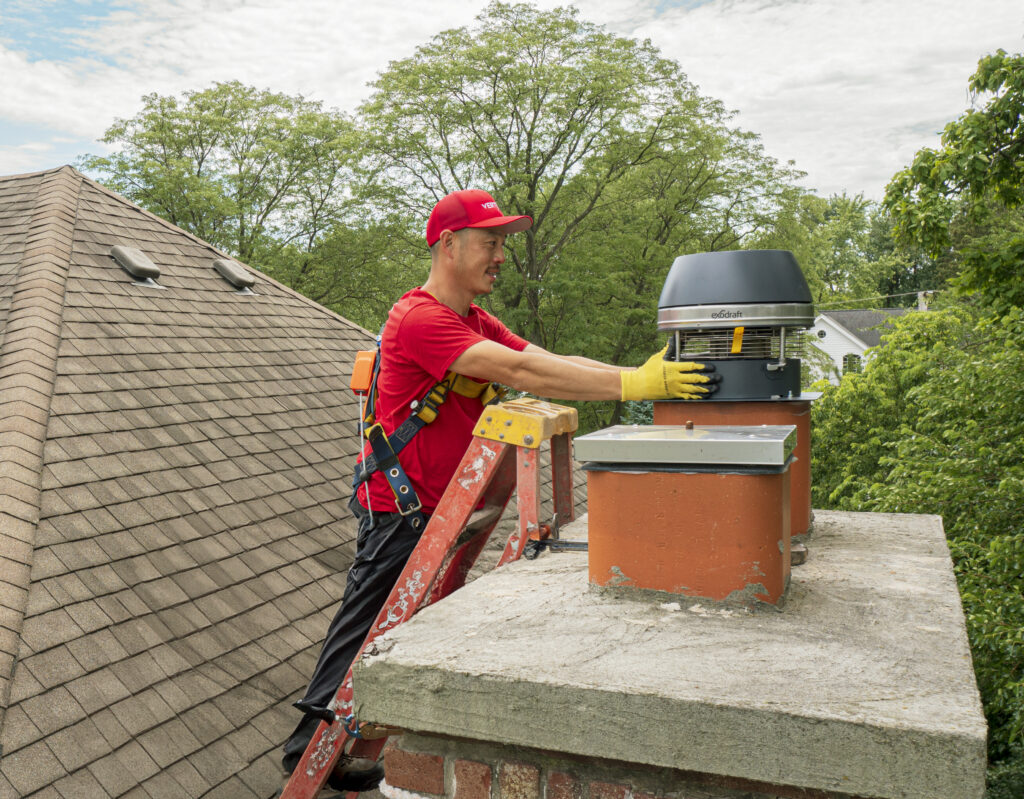
With a chimney comes an enjoyable fireplace that can bring your family and friends to gather round in celebration of holidays, birthdays, or a comfortable night inside. But the curse of a chimney is that it makes for an excellent home for rodents to set up camp, causing all sorts of problems for a homeowner.
Rodents inside of a chimney can send anyone into a panic. Who do you call? Do you opt for a pest removal service or a chimney expert? As a homeowner, you may wonder if you could save some money and do the job yourself.
Your first step, before you spiral into anxiety, is to determine the signs of rodents in the chimney.
Noises: Scurrying, scuttling, and scratching are dead giveaways that you have a rodent problem. While a chimney can soften the noises of animals living in the stack, it doesn’t mean that the critters are subject to just this area of the house. Pay close attention to sounds within your walls or attic.
Droppings: One of the nastiest parts about rodents sneaking in is their droppings. These unwanted “gifts” could be found anywhere, not just the fireplace, so be on the lookout in places you keep your food. When it comes to critter droppings, check for signs of defecation in cupboards, near walls, wall beams, containers, on counter-tops, or boxes.
Odors and Tracks: If rodents have moved inside your chimney, there is also a strong possibility that they might have died in there as well. Decomposing bodies of rats or mice will give off a repulsive odor that you can get a whiff of even if it's coming from inside of the chimney.
Live rodents have a musky smell, and you might notice little paw tracks throughout the house. Sprinkling talcum powder or flour can help you pinpoint their mode of entry.
Step One: Identifying and Preventing
By identifying possible entry points in your house, you can begin to seal them off. Rats and mice that are nesting in the chimney may have found another way inside of your home and then moved into the smokestack. When starting a fire in your fireplace, you might notice heavy smoke accompanied with a strong smell, this could be a rat nest caught on fire.
Before you begin the removal process, start with a few preventative measures. Seal any food containers and bags in heavy-duty storage bins, check your home for cracks and crevices that could allow critters to bypass, and make sure that any nesting materials, like paper, are stowed away. There’s no sense in setting traps if the animals keep finding their way inside.
Step Two: The Prep For Pest Removal
It's advisable to call in the experts to remove rodents from your chimney, but in some cases, you might be stuck with this unpleasant chore yourself. If this is your situation, don’t worry because your local hardware store carries all of the tools you will need to remove pests.
A trip to the store will present you with more than one option for pest traps. There are traps that kill rats or mice and others that keep them alive. It doesn’t matter which type you choose as long as you are comfortable with using whatever trap you select.
Traps can be tempting to the critters in the chimney when placed in the fireplace and coated with the smell of cheese or peanut butter. Don’t use rat poison if you have kids or pets and be sure to follow instructions listed on the packaging.
Step Three: The Removal
Successful traps will grant you with dead rats or mice or if you opted for live traps, you will have to deal with releasing the critters outside. Actually removing what you have caught in the traps is the major downside in DIY pest control. Be sure to release what you’ve caught outside, using protective gloves. If you used kill-traps, dispose of pests in a sealed trash bag, outside, and away from pets.
Step Four: Tending to Your Chimney
The aftermath of pest removal leaves you with a vulnerably exposed, and likely dirty, chimney. The last thing you’ll want is to have rats, mice, or other pests return to stow away in your chimney again, but there are steps you can take to prevent this from reoccurring.
There’s a chance that even after you have gone around your house and sealed up any cracks or crevices, you could have very well missed a few hidden in the chimney. Rodents could have easily entered through a crack in the mortar and discovered that the chimney is tucked away enough to make for a good place to set up inside.
As a homeowner with a chimney and a fireplace, it should be on your yearly checklist to have your chimney inspected and professionally cleaned. By doing so, you can make sure that no pests have nested inside and you can have a professional technician examine the chimney to check if it is functioning properly. A technician can also address any cracks in the mortar.
You can be proactive in blocking your chimney off from rodents and pests by installing a mesh-covered chimney cap. If you are unsure about what type of cap is right for your chimney, a professional fireplace technician or chimney inspector can help guide you in selecting one.
Make your home less attractive to rodents by keeping the tree limbs that hang over the roof of your house trimmed back and away to eliminate modes of entry. Also, store firewood, if you have a wood-burning fireplace, away from your home to prevent critters from hiding in the logs.
Paying Close Attention to Your Chimney
If you're unsure if rodents and other pests have made nests inside of your chimney, or if you are unaware of their presence, you might go to enjoy your fireplace and notice it's not venting properly. A professional mason should repair cracks and missing mortar joints.
Always pay close attention to your fireplace, even if you are certain that no birds, mice, rats, and other animals have nested within. If a nest is blocking the chimney from venting out smoke, carbon monoxide can become a serious and immediate hazard. Smoke can billow back out into your living space and affect you, your family, and your pets.
Your best bet is to call a professional to assist you in removing pests from your fireplace, but if this is not an option for you, then you can expect the DIY process of pest removal to take longer.
Most importantly, having a cap and mesh screen installed in your chimney can ultimately cut off this desirable entryway. Having your chimney inspected and cleaned each year can also curb these future headaches from happening.

Inspection and Clean
If there’s anything wrong with your chimney, we’ll find it and offer the best solution for you. We want your home to be safe. Since 1985, Vertical Chimney Care has served more thousands of homeowners with their chimney needs. Contact us today to speak with a product specialist.
